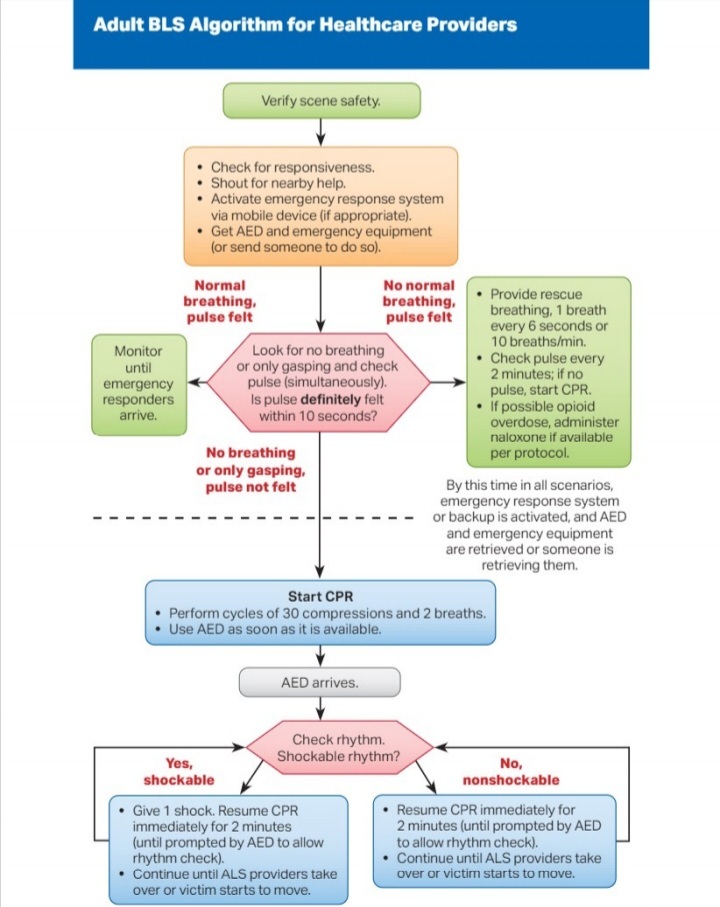(Images can be enlarged if needed)

Cardiac arrest, also known as Sudden Cardiac Arrest, is when the heart stops beating suddenly. The lack of blood flow to the brain and other organs can cause a person to lose consciousness, become disabled or die if not treated immediately.
The terms ‘heart attack’ and ‘cardiac arrest’ are often used interchangeably, but these are two different heart conditions.
A heart attack occurs when there is a blockage in the arteries that stops blood flow in the heart. Due to the lack of blood and oxygen flowing in the heart, the heart muscle tissue will become damaged. Heart attacks can increase the risk for cardiac arrest because heart attacks can alter electrical signals in the heart.
CPR – or Cardiopulmonary Resuscitation – is an emergency lifesaving procedure performed when the heart stops beating. Immediate CPR can double or triple chances of survival after cardiac arrest.
If someone experiences cardiac arrest, they need immediate treatment to increase the flow of oxygen-rich blood to their organs. CPR is the compression over the chest to manually pump a patients heart. Rescue breaths are preformed to provide oxygen to the body.
During CPR, proper hand placement on the lower half of the sternum is crucial. Placing hands over the sternum ensures effective chest compressions directly above the heart, optimizing blood circulation throughout the body.
According to the American Heart Association (AHA), the overall survival rate for out-of-hospital cardiac arrest is around 10%. However, survival rates can be improved if bystander CPR is started immediately. Studies have shown that bystander CPR increases the chances of survival for someone experiencing cardiac arrest. In fact, the AHA reports that survival rates increases to 40% or higher when bystander CPR is performed promptly. The surival rate is between 24% and 40% for those that happen in the hospital, according to the report published online in the Emergency Medicine Journal.
CPR is preformed between 100 - 120 beats per minute. Famously Staying Alive by the Bee Gees is the same beat. A large list of songs with the correct BPM can be found here
 The American Red Cross gives the following list of steps to asses if CPR is needed and how to preform:
The American Red Cross gives the following list of steps to asses if CPR is needed and how to preform:
1 CHECK the scene for safety, form an initial impression and use personal protective equipment (PPE)
2 If the person appears unresponsive, CHECK for responsiveness, breathing, life-threatening bleeding or other life-threatening conditions using shout-tap-shout
3 If the person does not respond and is not breathing or only gasping, CALL 9-1-1 and get equipment, or tell someone to do so
4 Kneel beside the person. Place the person on their back on a firm, flat surface
5 The American Red Cross CPR guidelines recommend 100 to 120 chest compressions per minute, 30 at a time. Remember these five points:
Hand position: Two hands centered on the chest
Body position: Shoulders directly over hands; elbows locked
Compression depth: At least 2 inches
Rate of compressions: 100 to 120 per minute
Allow chest to return to normal position after each compression
6
Give 2 breaths
Open the airway to a past-neutral position using the head-tilt/chin-lift technique Pinch the nose shut, take a normal breath, and make complete seal over the person’s mouth with your mouth. Ensure each breath lasts about 1 second and makes the chest rise; allow air to exit before giving the next breath Note: If the 1st breath does not cause the chest to rise, retilt the head and ensure a proper seal before giving the 2nd breath If the 2nd breath does not make the chest rise, an object may be blocking the airway
7 Continue giving sets of 30 chest compressions and 2 breaths. Use an AED as soon as one is available! Minimize interruptions to chest compressions to less than 10 seconds.
Sources:
https://www.hopkinsmedicine.org/health/conditions-and-diseases/cardiac-arrest
https://cpr.heart.org/en/resources/cpr-facts-and-stats
https://www.mycprcertificationonline.com/blog/cpr-success-rate
Instructional images from the AHS Basic Life Support Manual (2020)
Join our public Matrix server! https://matrix.to/#/#tracha:chapo.chat
As a reminder, be sure to properly give content warnings and put sensitive subjects behind proper spoiler tags. It’s for the mental health of not just your comrades, but yourself as well.
Here is a screenshot of where to find the spoiler button.



spoiler
It got better for me over time, on average. Is it better than 2 years ago, at least, on average?
spoiler
It’s definitely better than it used to be. I used to spend the vast majority of my time either self-harming or thinking about suicide. I didn’t really care much for anything back then, so I’m doing better now. I just have a hard time coping when my dysphoria gets bad. Like I often cry because I’ll never have kids or thinking about how much puberty ruined me.
So yeah it’s definitely better now on average than it used to be, I just find it hard to have any hope for the future. Most of my goals in life (getting married, having kids, moving abroad) are complicated or straight up impossible due to being trans :(
spoiler
Yeah, I know this feeling a bit. I try to focus as hard as I can on a good time when it starts to hit. There’s days I can’t look in the mirror, I rarely take photos. If you feel gender euphoria, it can help on your good days maybe to really lean into that. And on bad days, distract yourself. If it’s gotten better than it used to be, there’s reasonable evidence to suggest that it will continue to improve over time (on average, some days can feel like setbacks for sure)
This is just what works for me. There are many things I can’t do because of all sorts of reasons in my life. Sometimes, I long for them. I wish I could have Perfect Best Friends, focus more at work, know wtf I’m doing with bottom surgery, move to another country or state, etc. you know? I can’t let these things consume me or I’m lost, so I try my best to focus on the things I can do that I enjoy. It took me a very long time to find them. I got into all sorts of hobbies, learned a few musical instruments, made music for games in my spare time, met some funny people online to play games with, etc etc.
I do mourn the things I can’t do, occasionally. I think that’s important, too.
We will never be able to do everything we want, and I guess it took me too long to realize this wasn’t just a gender thing for me.
I hope this helps, I’m not a professional, you just reminded me of me when I was a tiny bit younger is all.